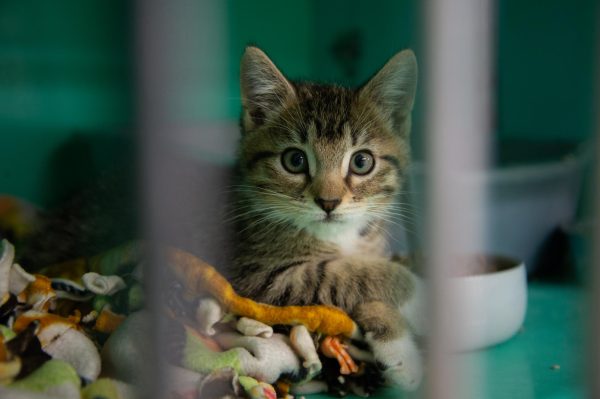Support animals help with change
January 25, 2017
Our animal companions provide unconditional love and affection. But for some, these animals provide much-needed support.
An Emotional Support Animal (ESA) gives necessary comfort and support for those suffering from mental illness. In dealing with depression, anxiety disorders, post-traumatic stress disorder and other mental health challenges, ESAs tend to have a positive impact on emotional wellbeing.
Makayla Clarke, freshman zoology major, adopted her cat Piper five years ago in her hometown of Yakima. Her family rescued stray cats from around her neighborhood and occasionally adopted them. She rescued two cats when she was eight years old, and believed they were both girls. One turned out to be male, and they eventually became Piper’s parents. Clarke has had her ever since.
To bring Piper to WSU, Clarke needed a thorough doctor’s note, stating her mental illness and resulting need for an emotional support animal. The note stated her depression, generalized anxiety disorder and possible bipolar disorder, along with a list of medications she has been taking to manage, Clarke said.
Then, taking the note and medication list, she went to the access center (located in the Washington Building) and scheduled an appointment with a counselor. They assessed Clarke’s situation to see if she needed an ESA.
Clarke took the process a bit further by printing out flyers for everyone on her dorm’s floor to see if anyone was allergic. It also helps to live alone, Clarke said. Since she doesn’t have a roommate, it was less of an issue to have Piper with her.
It even played a big role in deciding whether she could bring Piper in the first place, she said. Because Piper is a cat, she requires more space, along with food and a litterbox, so advisers do prefer solo living arrangements.
Clarke is still in the process of getting official statewide recognition for Piper. At usserviceanimals.org, a registry for service animals and emotional support animals, Clarke applied for Piper and will receive an animal ID card, printed certification, digital copies and a vest for Piper.
Emotional support animals tend to be small dogs, cats, birds, reptiles and any other animal that bonds with its owner, Clarke said. While service dogs can go into classrooms and most other places, ESAs stay in the home environment or may go on airlines if needed.
At first, Clarke had no idea who to go to about bringing Piper to her dorm. She originally went to counseling services, but since the doctor didn’t know Clarke very well, they couldn’t write the note, she said.
Once Clarke did a little more research, she found out she had to go to the Access Center. It took three to four weeks waiting for appointments, but after the first appointment, Clarke realized she could definitely have Piper with her. As long as there is an obvious need, the university tends to be pretty lenient, she said.
Having Piper with her has made a huge difference, Clarke said. Especially since she does live alone and cannot hang out with her friends every single waking moment, she said coming home to Piper really helped her.
“It’s like coming home to a roommate that doesn’t talk,” Clarke said. “Plus, you get cuddle benefits.”
With her depressive and anxiety disorders, Clarke said she has a hard time adjusting to change, so having Piper gives her a connection to home. Piper helped in transitioning to college, she said. As with most emotional support cats, they do not go through any sort of training. The human-animal bond itself provides all the benefits.
Piper also acts as a service animal for the entire floor, Clarke said. Especially during midterms and finals week, people come just to play with Piper. Once, the entire floor above her came down to see Piper, which Clarke found a little odd since she didn’t really know any of them. Most people don’t even realize she has a cat in her room, she said.
When asked for advice to give to people seeking to bring their emotional support animals, Clarke said to go for it. But people should also keep the animal’s welfare in mind. Since Piper is fairly young, she does pretty well. But if she were 10- to 12-years-old, it would be best if she stayed at home, Clarke said. It comes down to what’s best for you and your animal.
“As much as she’s a support for me, I’m a support for her too,” Clarke said.
Clarke also noted that people should make sure they need their animal with them. Because if they don’t, it makes it much harder for people who really need them, she said.
She said they should also make sure the animal can receive the best care possible. With college, finances might make buying proper food and supplies a challenge, so considering that beforehand is very important.
Time spent in the dorm also plays a part in having an animal in the dorm. If students stay out the majority of the time without socializing with their animal, that defeats the purpose, Clarke said. Occasionally, when spending time in a friend’s room on the same floor, Clarke will bring her cat with her, just to make sure Piper gets enough social interaction.
The Federal Fair Housing Act officially allows ESAs into university housing. Students seeking to have their emotional support animal on campus can contact the WSU Access Center for permission.






















